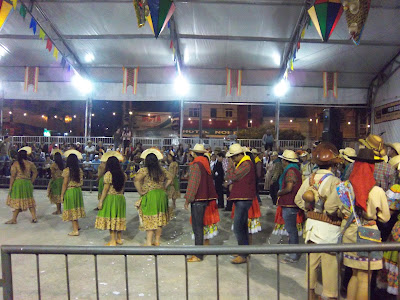Yesterday we went to Caruaru which is about two hours west of Recife. It sits on the beginning of the Sertão (savanna/desert-see my mission pictures from Tocantins) and it was fun to see the scenery change as we went inland.
 |
| A much different landscape further inland |
The Northeast has two types of music that tell the story of the Northeast, the Sertão and the Sertenajos (people of the Sertão-think of Texans, but not winning often...or at all); Forró and Baião. The usual instruments include the accordion (which always reminds me of Grandpa Bob), triangle and zabumba drum. The Sertão can be a harsh place to live with little rainfall so many Brazilians from the Northeast will leave for São Paulo, Rio de Janeiro and Brasília looking for jobs. Part of the forró themes is the idea of returning to the Sertão, like the diaspora of the Jews from Jerusalem.
Caruaru is the capital of Forró and for almost two weeks straight has huge shows with singers and quadrilha dances. Instead of writing about what I saw, let me show you.
 |
| Caruaru |
 |
| Example of the Quadrilha |
 |
| Luis Gonzaga, the Father of Baião and Forró. |
Luis Gonzaga was one of the most influential singers of
Baião and Forró. He left the Northeast to Rio de Janeiro. While there he played
accordion for all types of music, but found fame among the Northeastern
(Nordestinos). His most famous song is "Asa Branca" or "White
Wing". Check it out on Youtube:http://www.youtube.com/watch?v=A5r2_wGk1dI
 |
| Josh with his newly acquired Nordestino cowboy hat |
I loved the music and the traditional dancing (definitely did not like the newer dancing) and had a great time with the traditions of the Sertão.


No comments:
Post a Comment